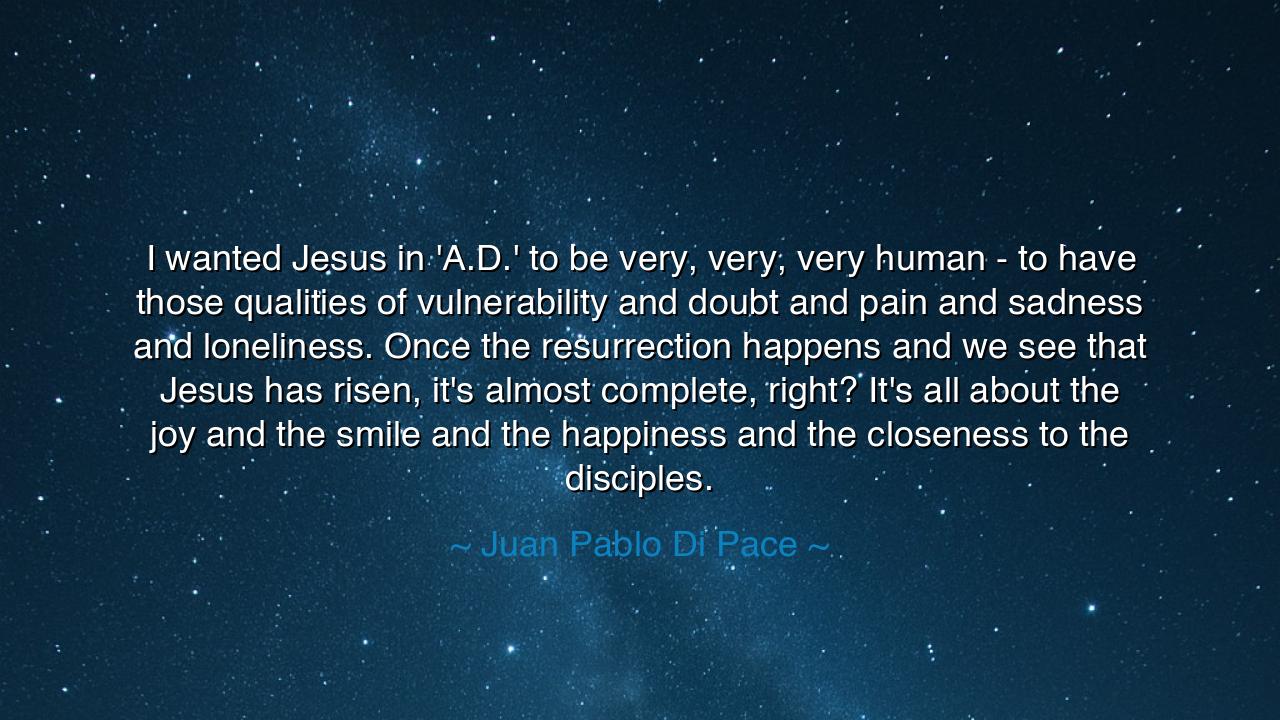
I wanted Jesus in 'A.D.' to be very, very, very human - to have
I wanted Jesus in 'A.D.' to be very, very, very human - to have those qualities of vulnerability and doubt and pain and sadness and loneliness. Once the resurrection happens and we see that Jesus has risen, it's almost complete, right? It's all about the joy and the smile and the happiness and the closeness to the disciples.






Juan Pablo Di Pace, reflecting on his portrayal of the Christ in the series A.D., once said: “I wanted Jesus in ‘A.D.’ to be very, very, very human—to have those qualities of vulnerability and doubt and pain and sadness and loneliness. Once the resurrection happens and we see that Jesus has risen, it’s almost complete, right? It’s all about the joy and the smile and the happiness and the closeness to the disciples.” In this confession lies not only an artist’s choice, but a truth as old as the Gospel itself: that the path to triumph first passes through suffering, and that the light of joy shines most brilliantly when it has emerged from the shadow of sorrow.
The ancients understood this pattern deeply. The Greeks gave us the tragedies of heroes who suffered before attaining wisdom, and the Hebrews told of Job, stripped of all comfort before his faith was renewed. In the figure of Jesus, Di Pace sought to embody this timeless pattern: to show that divinity itself was not clothed in untouchable perfection, but in the full range of human frailty—vulnerability, doubt, and loneliness. Only by walking the path of tears could he, and we, know the true weight of the smile after the storm.
Consider the moment of the cross: the Christ crying out in abandonment, “My God, my God, why have you forsaken me?” It is in that cry that all humanity is gathered—the agony of every mortal who has ever felt alone. Di Pace’s desire to show this side of Christ is an act of reverence, not diminishment, for it reminds us that greatness does not bypass pain but redeems it. And when the resurrection comes, when the stone is rolled away, the triumph is not abstract—it is deeply personal, forged in the furnace of suffering.
History echoes this rhythm again and again. Nelson Mandela, imprisoned for twenty-seven years, emerged not with bitterness but with a smile, embracing reconciliation instead of vengeance. His joy after long loneliness was not naive—it was hard-won, like the happiness of Christ after the tomb. So too with countless men and women who have endured grief and yet chosen to rise again; their triumph is believable precisely because their suffering was real.
Mark this well: joy without sorrow is shallow, but joy after sorrow is eternal. The smile Di Pace speaks of—the smile of the risen Christ among his disciples—is not the grin of ignorance, but the radiance of one who has conquered despair. It is this kind of smile that has the power to heal others, to strengthen communities, and to bring closeness where once there was fear. The disciples, broken and scattered in grief, were gathered not by power alone, but by the simple and profound presence of the smile of their risen Lord.
Practical wisdom flows from this: do not fear your vulnerability, your pain, or your moments of loneliness. These are not signs of weakness, but the very soil in which your future joy is planted. When you endure them with honesty, you prepare yourself for a resurrection of your own—whether in the form of healing, reconciliation, or newfound strength. And when that moment comes, let your smile be genuine, carrying the weight of the sorrows you have overcome.
Therefore, O seeker, let Juan Pablo Di Pace’s words guide you: embrace the fullness of your humanity, both the tears and the laughter. For the story is not complete until after the resurrection, when sorrow turns into joy, when loneliness becomes closeness, and when the broken spirit rises with a radiant smile. This is the rhythm of all true life: to suffer, to endure, and then to rise—and in rising, to bring light to those who still dwell in shadow.






AAdministratorAdministrator
Welcome, honored guests. Please leave a comment, we will respond soon